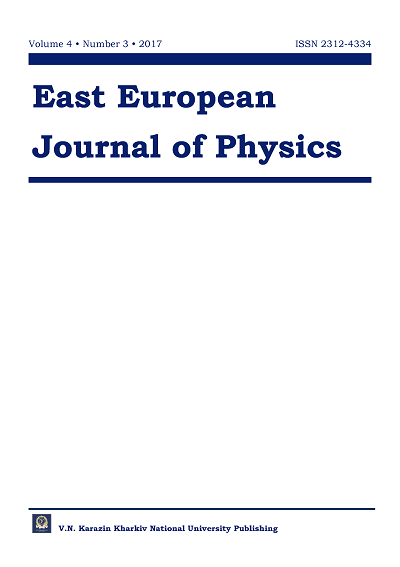THERMODYNAMICS OF THE FERMI GAS IN A NANOTUBE
Abstract
For the ideal Fermi gas that fills the space inside a cylindrical tube, there are calculated the thermodynamic characteristics in general form for arbitrary temperatures, namely: the thermodynamic potential, energy, entropy, equations of state, heat capacities and compressibilities. All these quantities are expressed through the introduced standard functions and their derivatives. The radius of the tube is considered as an additional thermodynamic variable. It is shown that at low temperatures in the quasi-one-dimensional case the temperature dependencies of the entropy and heat capacities remain linear. The dependencies of the entropy and heat capacities on the chemical potential have sharp maximums at the points where the filling of a new discrete level begins. The character of dependencies of thermodynamic quantities on the tube radius proves to be qualitatively different in the cases of fixed linear and fixed total density. At the fixed linear density these dependencies are monotonous and at the fixed total density they have an oscillating character.
Downloads
References
P. 437-672.
2. Komnik Y.F. Physics of metal films. − Moscow: Atomizdat, 1979. − 264 p. (in Russian)
3. Dragunov V.P., Neizvestnyj I.G., Gridchin V.A. Fundamentals of nanoelectronics. − Moscow: Fizmatkniga, 2006. − 496 p. (in
Russian)
4. Vagner I.D. Thermodynamics of two-dimensional electrons on Landau levels // HIT J. of Science and Engineering A. − 2006. −
Vol. 3. − P. 102-152.
5. Freik D.M., Kharun L.T., Dobrovolska A.M. Quantum-size effects in condensed systems. Scientific and historical aspects //
Phys. and Chem. of Solid State. − 2011. − Vol. 12. − P. 9-26.
6. Shaginyan V.R., Popov K.G. Strongly correlated Fermi-systems: theory versus experiment // Nanostuctures. Mathematical
physics and modeling. − 2010. − Vol. 3. − P. 5-92.
7. Landau L.D., Lifshitz E.M. Statistical physics, Vol. 5. − Oxford: Butterworth-Heinemann, 1980. − 544 p.
8. Poluektov Yu.M., Soroka A.A. Thermodynamics of the Fermi gas in a quantum well // East Eur. J. Phys. − 2016. − Vol. 3,
No.4. − P. 4-21; arXiv:1608.07205 [cond-mat.stat-mech].
9. Tomonaga S., Remarks on Bloch’s method of sound waves applied to many-fermion problems // Progr. Theor. Phys. − 1950. −
Vol. 5. − P. 544-569.
10. Luttinger J.M. An exactly soluble model of a many-fermion system // J. Math. Phys. − 1963.− Vol. 4. − P. 1154-1162.
11. Deshpande V.V., Bockrath M., Glazman L.I., Yacoby A. Electron liquids and solids in one dimension // Nature. − 2010. − Vol. 464 (11). − P. 209-216.
12. Landau L.D., The theory of a Fermi liquid // Sov. Phys. JETP. − 1957. − Vol. 3. − P. 920-925.
13. Pines D., Nozières P. The theory of quantum liquids, Vol. I. − New York: Benjamin, 1966. − 149 p.
14. Abramowitz M., Stegun I. (Editors), Handbook of mathematical functions. − Moscow: Nauka, 1979. − 832 p.
Authors who publish with this journal agree to the following terms:
- Authors retain copyright and grant the journal right of first publication with the work simultaneously licensed under a Creative Commons Attribution License that allows others to share the work with an acknowledgment of the work's authorship and initial publication in this journal.
- Authors are able to enter into separate, additional contractual arrangements for the non-exclusive distribution of the journal's published version of the work (e.g., post it to an institutional repository or publish it in a book), with an acknowledgment of its initial publication in this journal.
- Authors are permitted and encouraged to post their work online (e.g., in institutional repositories or on their website) prior to and during the submission process, as it can lead to productive exchanges, as well as earlier and greater citation of published work (See The Effect of Open Access).








